SAP Leonardo IoT and Edge Computing
SAP Leonardo IoT and Edge Computing.
Internet of Things (IoT) has been a buzz word for the past few years. The advent of affordable and reliable electronic sensors, the IoT use cases have picked up lot of steam. SAP delivered Leonardo services as a way to build intelligent enterprises, which includes IoT and IoT Edge as one of the components (among others). This earlier blog on SAP Leonardo provides an overview. This blog is a primer specifically on SAP Leonardo IoT and IoT Edge computing with an example use-case to understand this better.
IoT and Edge Computing.
Wikipedia defines IoT as, a system of interrelated computing devices, mechanical and digital machines provided with unique identifiers and the ability to transfer data over a network without requiring human-to-human or human-to-computer interaction.
Gartner has given a slightly simpler definition and it states, IoT is the network of physical objects that contain embedded technology to communicate and sense or interact with their internal states or the external environment.
Wikipedia defines Edge Computing as, a distributed computing paradigm which brings computation and data storage closer to the location where it is needed, to improve response times and save bandwidth.
In simple terms, IoT and Edge Computing relies on a set of sensors, which measure pre-defined parameters from its installed environment and transmit the same to a system residing in nearby location, termed as Edge, or a system residing far away in a “cloud”. There are many types of sensors available today to measure different parameters such as temperature, pressure, motion, position, sound etc. The location of measurement can be an oil rig in high seas, or a manufacturing bay with multiple machines, or a mobile vehicle carrying goods by road or rail. The following diagram in exhibit-1 explains what Edge Computing looks like.
Exhibit-1 (Credits : SAP SE) 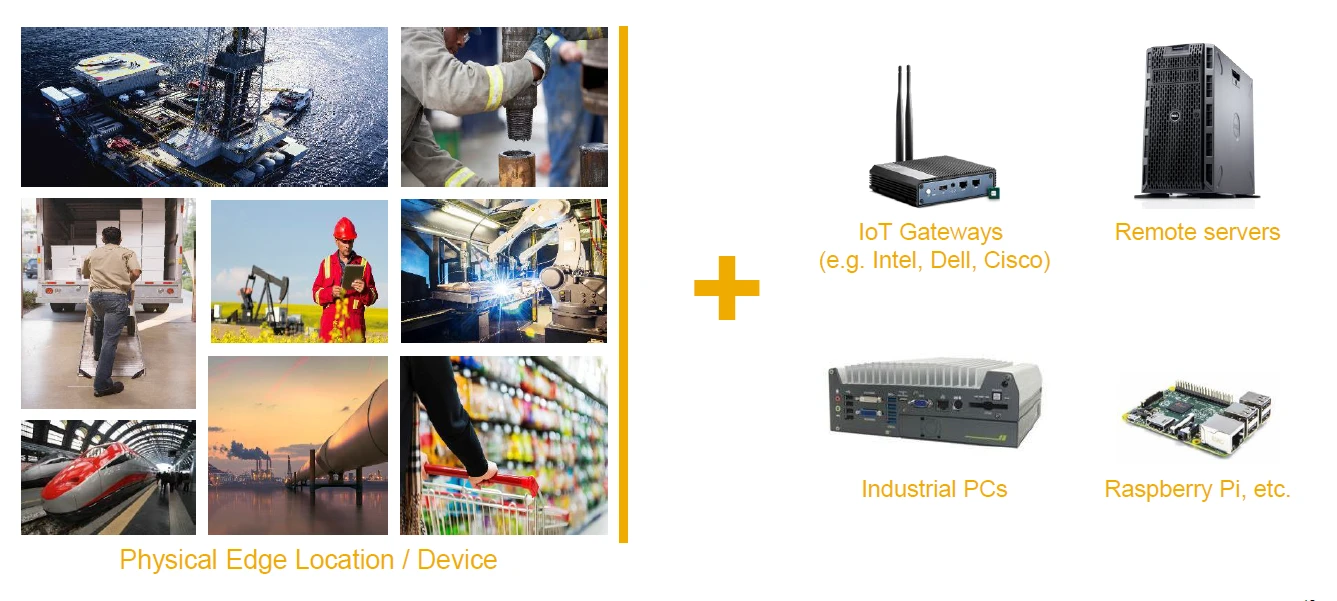
SAP IoT in the Cloud Services
At a high level, one needs to understand data is being collected from multiple sensors and then needs to be validated & converted into a required format and stored. Then they must be analysed and relevant information has to be provided in a given business context for initiation of the necessary action. There are three broad categories of services, as follows:
- Enablement of digital twin
- Data Ingestion and Big Data storage
- Analytics, Rules, Events and Decision Support Services
Enablement of Digital Twin
These enable one to onboard the multitudes of devices, linking them with their unique identifiers, and securely connect to these remote devices over a broad variety of IoT Protocols (SDK’s to enable additional protocols). The services enable full life cycle management of devices from new devices onboarding until decommissioning at end-of-life or defunct ones. It provides for master data integration with business partners and support space-hierarchies for location mapping and floor plans. The following exhibit-2 gives a brief of these pictorially.
Exhibit-2 (Credits: SAP SE)
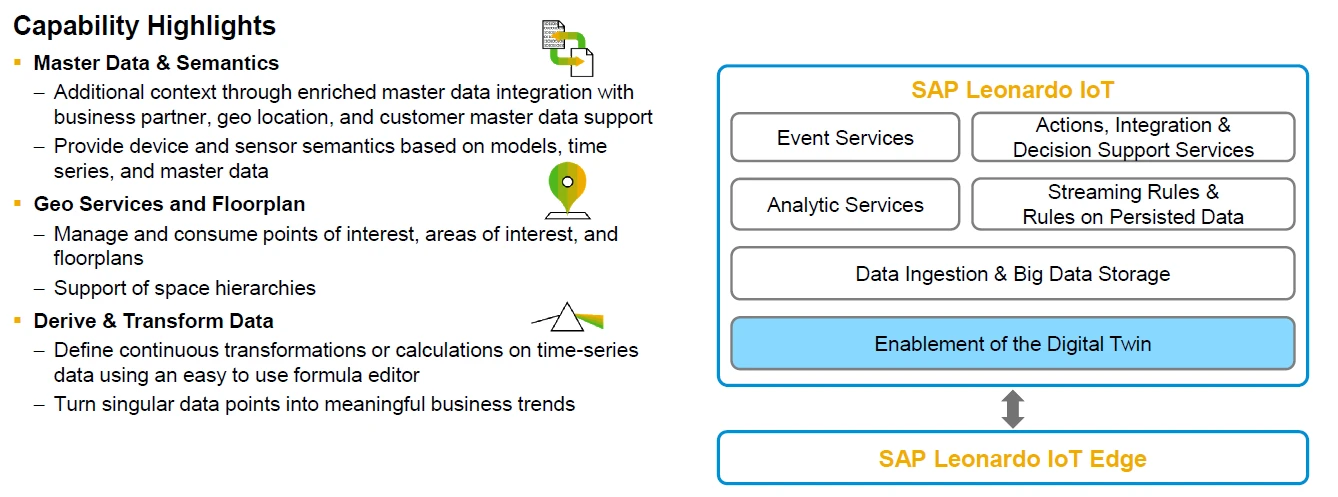
Data Ingestion and Big Data Storage
These services provide for data validation of the incoming data from devices and store them in appropriate tables. There is an automatic data tiering system available into hot, warm and cold storage areas. Hot storage is for high performance accessing with SQL. Warm storage is for subsequent accesses for calculations etc, typically for a few months. Cold storage is for historical retention and comparisons, typically for multiple years. There are APIs available for accessing raw data in any of these data tiers to run analytics or create time-series aggregates. The following exhibit-3 provides the info in a graphical form below.
Exhibit-3 (Credits: SAP SE)
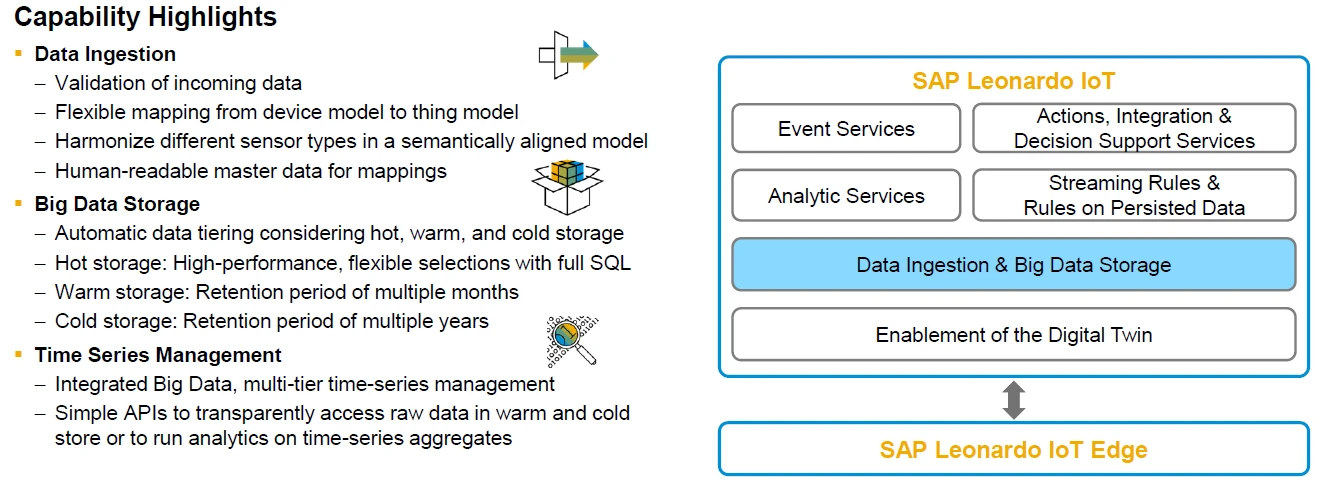
Analytics, Rules, Events and Decision Support Services
These enable aggregation of data in different dimensions with calculation views. It is also possible to connect SAP Analytics cloud for bringing the live data in a correct business context. Rules can be administered on the incoming data as well as persisted data. They can be scheduled to perform at different time intervals. Actions can be initiated in a business process integrated manner and support decisions with response options. The following exhibit-4 graphically summarize these points below.
Exhibit-4 (Credits SAP SE)

SAP Edge Services
SAP provides powerful “microservices”, which can be deployed on Edge Computing devices like IoT gateways or Industrial PCs at site or devices like Raspberry Pi, etc. This helps to extend the processing power of the cloud to the Edge devices. SAP Cloud Platform for IoT services and SAP Edge Services work in tandem to deliver both cloud and edge services in unison. There is a “Policy Service” that allows one to manage, configure and mass deploy micro services to Edge devices, centrally from a cloud control panel.
The power of edge computing lies in executing the business processes locally in real-time eliminating latency. For example, avoiding collision of a crane in a construction site would need an instantaneous response when the crane is operating on the wrong course. Another advantage is that, the edge computing devices can work independently without having a need to have “always-on” connectivity to cloud. It can intermittently connect to cloud and sync. This helps to reduce data transmission costs and can use optimization techniques with upstream cloud channel. This can be very helpful, especially in situations like high-seas connection, which use high cost satellite links. The following exhibit 5, diagrammatically explains the same.
Exhibit-5 (Credits: SAP SE)
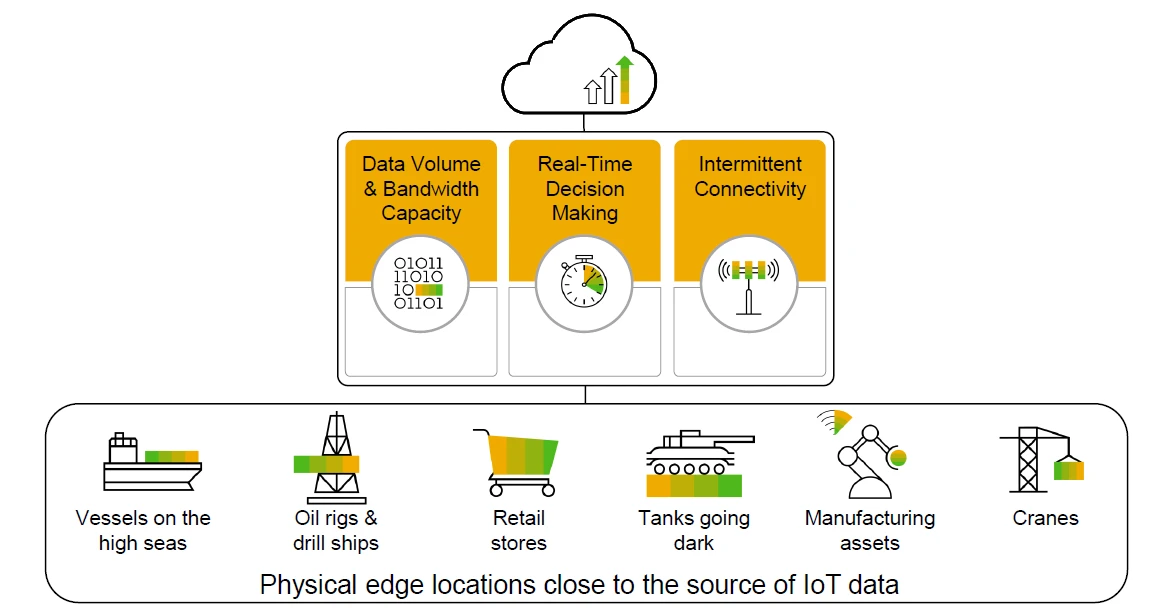
SAP Edge Services are available in the following four categories.
- Essential Business Functions Service
- Streaming Service
- Persistence Service
- Custom Edge Services
Essential Business Functions (EBF) Service
These services are, as the name implies, the business context data and transactions from SAP ERP or C/4HANA and Asset Intelligent Network can be deployed in Edge devices. For example, in the Plant Maintenance module certain ERP transactions used by the maintenance engineer working on-site of a large plant can use the transaction in a remote device. Similarly, a service technician needing critical info of an equipment to service at customer site (in his/her iPad for example) gets it via persistence service. This is explained later in the blog below, as a use-case. The following exhibit-6 diagrammatically explains this service below.
Exhibit-6 (Credits : SAP SE)

Streaming Service
Rules can be defined for analysing incoming data from sensors to edge device in real time at the edge device itself. Rules can also trigger business processes when certain thresholds are reached. This service can also carry out smart data compression of data sent to cloud. The following exhibit-7 explains the service with more information below.
Exhibit-7 (Credits:SAP SE)
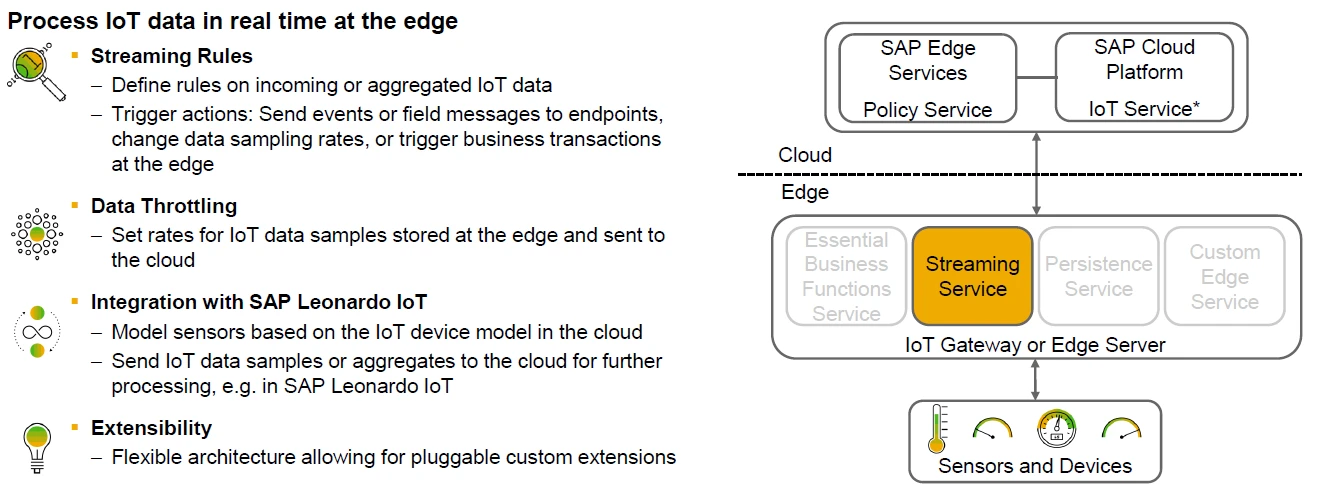
Persistence Service
Persistence Service provides the ability to store data and host custom applications in the edge device. Users can create schema for custom tables and read/write data in these tables residing in the edge device. Data retention policies can be defined for the persisting data stored in the edge device and custom applications can utilize this data. Custom applications can also access data in the cloud and other business contexts using a variety of APIs provided in persistence service. The diagram in exhibit- 8 gives a summary of these capabilities.
Exhibit-8 (Credits: SAP SE)
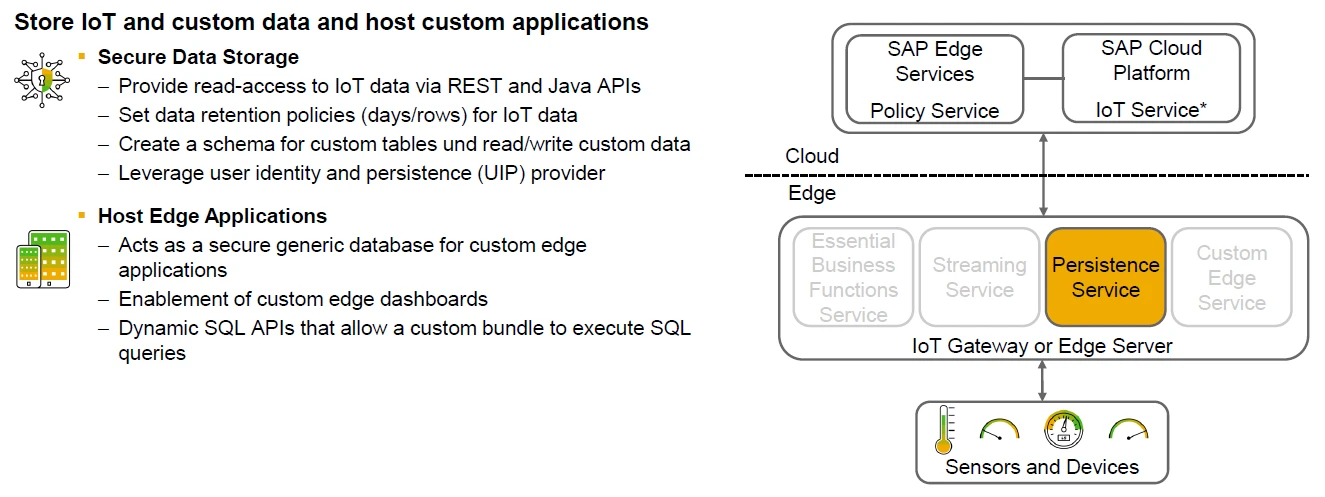
Custom Edge Services
These are custom built services created by the customer, specific to their business environment. They can be built using EBF, Persistent and Streaming services. These custom edge services can be built in the Cloud and deployed using Policy Service. It is also possible to build predictive models in the cloud, train them with the data available in the cloud and then deploy it using policy services into the edge device. An example use-case scenario is predictive maintenance and predictive quality models specific to a customer environment. The diagram in exhibit-9 gives a summary of the capabilities.
Exhibit-9 (Credits: SAP SE)
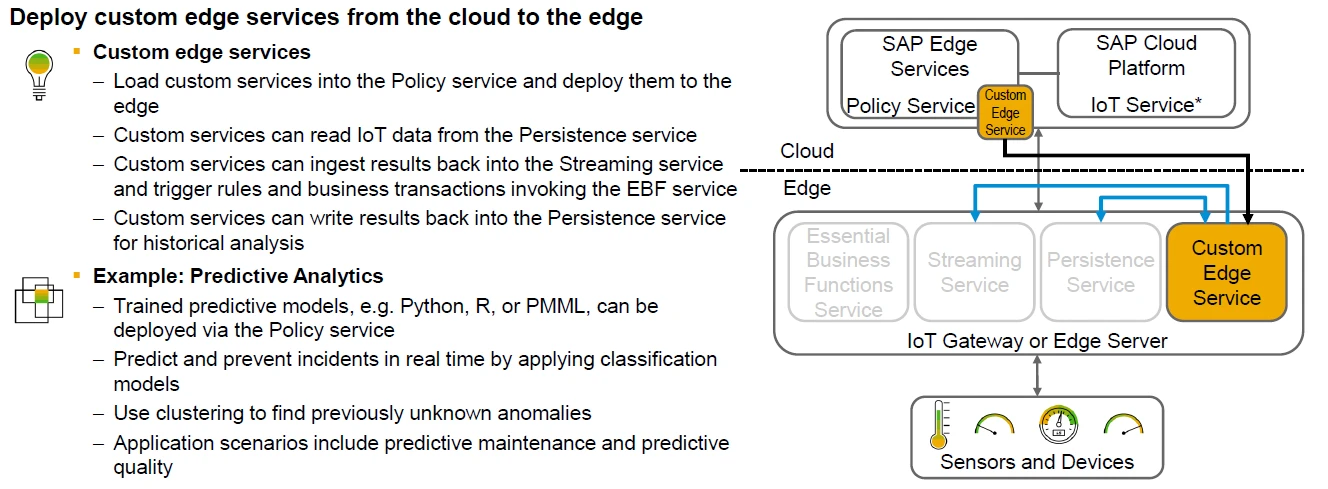
Example Use-Case: Extending Field Service Management to Edge
Let us consider the example of an equipment manufacturer. Often large equipment manufacturers typically need to provide their service at the customer premises. It is possible to install an edge computing device in the customer premises and it collects key health parameters of the equipment live. Based on the threshold values, the edge device can proactively trigger necessary alerts to the customer and also a field service request to the manufacturer. This can help identify the issues in the equipment in a timely manner and avoid costly down times. The diagram in exhibit-10 below shows one such scenario pictorially.
Exhibit-10 (Credits: SAP SE)
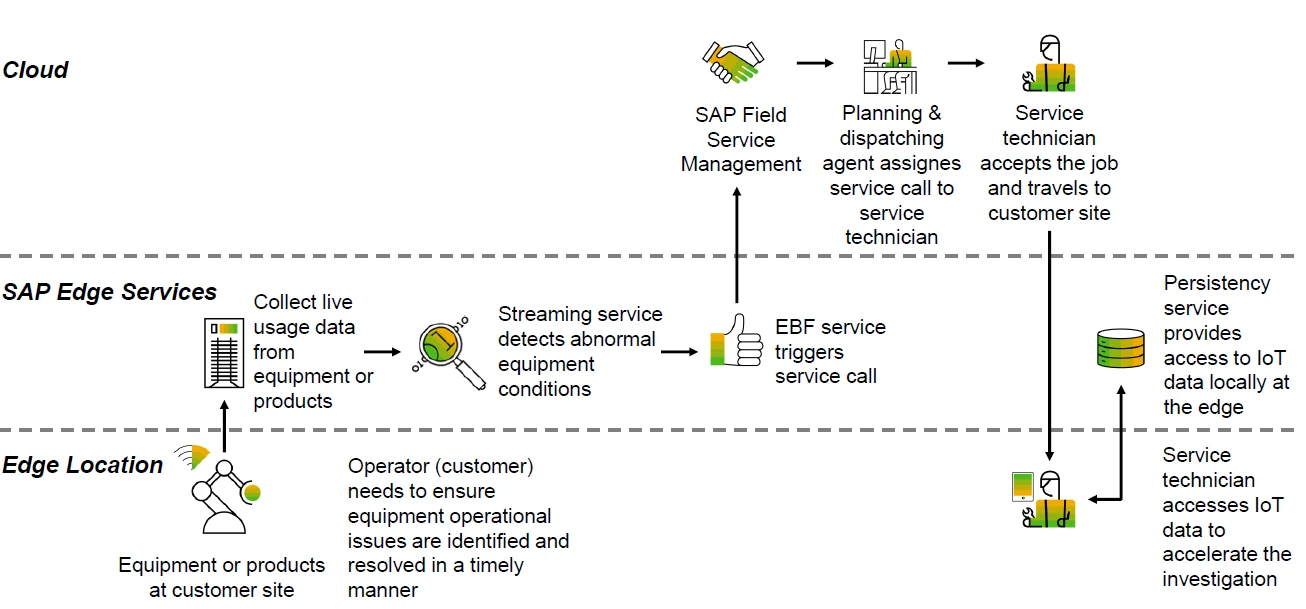
Summary
SAP has comprehensively provided the solution to handle IoT and Edge Computing usage challenges, especially inter-weaving them with business processes. However it is still a developing area, in terms of technological developments in sensor and communication technologies. SAP is also providing education on “How to use Edge Services”- see the reference link below. There is also a reference below on a step-by-step implementation of IoT Services in one of the recent SAP Blogs, which can be explored by interested Consultants. The roll-out of 5G technologies will help to fully exploit the potential of IoT and Edge computing. The current downturn in the economy is a good time to look for new opportunities to simplify business process and make them smart.
Author : Ravi Srinivasan, SAP Alumni